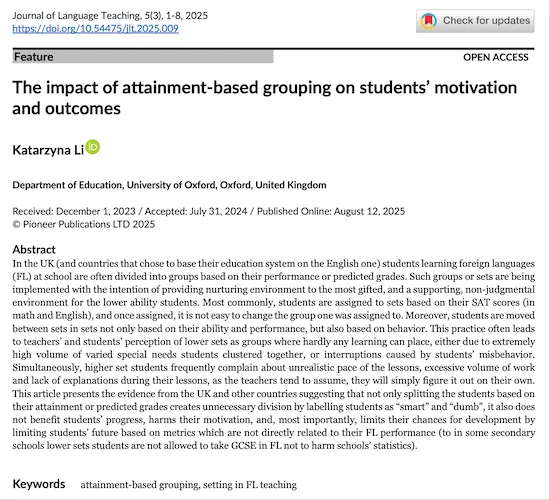The impact of attainment-based grouping on students’ motivation and outcomes
DOI:
https://doi.org/10.54475/jlt.2025.009Keywords:
attainment based grouping, setting in FL teachingAbstract
In the UK (and countries that chose to base their education system on the English one) students learning foreign languages (FL) at school are often divided into groups based on their performance or predicted grades. Such groups or sets are being implemented with the intention of providing nurturing environment to the most gifted, and a supporting, non-judgmental environment for the lower ability students. Most commonly, students are assigned to sets based on their SAT scores (in math and English), and once assigned, it is not easy to change the group one was assigned to. Moreover, students are moved between sets in sets not only based on their ability and performance, but also based on behavior. This practice often leads to teachers’ and students’ perception of lower sets as groups where hardly any learning can place, either due to extremely high volume of varied special needs students clustered together, or interruptions caused by students’ misbehavior. Simultaneously, higher set students frequently complain about unrealistic pace of the lessons, excessive volume of work and lack of explanations during their lessons, as the teachers tend to assume, they will simply figure it out on their own. This article presents the evidence from the UK and other countries suggesting that not only splitting the students based on their attainment or predicted grades creates unnecessary division by labelling students as “smart” and “dumb”, it also does not benefit students’ progress, harms their motivation, and, most importantly, limits their chances for development by limiting students’ future based on metrics which are not directly related to their FL performance (to in some secondary schools lower sets students are not allowed to take GCSE in FL not to harm schools’ statistics).
References
Bradley, E. H., Curry, L. A., & Devers, K. J. (2007). Qualitative data analysis for health services research: developing taxonomy, themes, and theory. Health Services Research, 42(4), 1758-1772. https://doi.org/10.1111/j.1475-6773.2006.00684.x DOI: https://doi.org/10.1111/j.1475-6773.2006.00684.x
Friedrich, A., Flunger, B., Nagengast, B., Jonkmann, K., & Trautwein, U. (2015). Pygmalion effects in the classroom: Teacher expectancy effects on students’ math achievement. Contemporary Educational Psychology, 41, 1–12. https://doi.org/10.1016/j.cedpsych.2014.10.006 DOI: https://doi.org/10.1016/j.cedpsych.2014.10.006
Hallam, S., & Ireson, J. (2005). Secondary school teachers' pedagogic practices when teaching mixed and structured ability classes. Research Papers in Education, 20, 3-24. https://doi.org/10.1080/0267152052000341318 DOI: https://doi.org/10.1080/0267152052000341318
Kim, Y. (2012). Implementing ability grouping in EFL contexts: Perceptions of teachers and students. Language Teaching Research, 16(3), 289–315. https://doi.org/10.1177/1362168812436894 DOI: https://doi.org/10.1177/1362168812436894
Kulik, C. C., & Kulik, J. A. (1982). Effects of ability grouping on secondary school students: A meta-analysis of the evaluation findings. American Education Research Journal, 19, 415-428. https://doi.org/10.2307/1162722 DOI: https://doi.org/10.3102/00028312019003415
Mazenod, A., Francis, B., Arche, L., Hodgen, J., & Taylor, B. (2019). Nurturing learning or encouraging dependency? Teacher constructions of students in lower attainment groups in English secondary schools. Cambridge Journal of Education, 49, 53-68. https://doi.org/10.1080/0305764X.2018.1441372 DOI: https://doi.org/10.1080/0305764X.2018.1441372
McCoach, D., O’Connell, A., & Levitt, H. (2006). Ability grouping across kindergarten using. The Journal of Educational Research, 99, 339–46. https://doi.org/10.3200/JOER.99.6.339-346 DOI: https://doi.org/10.3200/JOER.99.6.339-346
Rosenholtz, S., & Simpson, C. (1984). The formation of ability conceptions: Developmental trend or social construction? Review of Educational Research, 54, 31–93. https://doi.org/10.3102/00346543054001031 DOI: https://doi.org/10.2307/1170397
Rosenthal, R., & Jacobson, L. (1968). Pygmalion in the classroom: Teacher expectation and pupils’ intellectual development. New York: Holt, Rinehart and Winston. https://doi.org/10.1007/BF02322211 DOI: https://doi.org/10.1007/BF02322211
Sahlberg, P. (2012). A Model LessonFinland Shows Us What Equal Opportunity Looks Like. American Educator. https://files.eric.ed.gov/fulltext/EJ971754.pdf
Saleh, M., Lazonder, A., & Jong, T. (2005). Effects of within-class ability grouping on social interaction, achievement, and motivation. Instructional Science, 33, 105–119. https://psycnet.apa.org/doi/10.1007/s11251-004-6405-z DOI: https://doi.org/10.1007/s11251-004-6405-z
Sheppard, C., Manalo, E., & Henning, M. (2018). Is ability grouping beneficial or detrimental to Japanese ESP students’ English language proficiency development? English for Specific Purposes, 48, 39–48. 10.1016/j.esp.2017.10.002 DOI: https://doi.org/10.1016/j.esp.2017.10.002
Webb, N., & Palinscar, A. (1996). Group processes in the classroom. In D. C. Berliner, & R. Calfee (Eds.), Handbook of Educational Psychology (pp. 841–873). MacMillan.
Yusuf, Y. Q., Inayah, N., & Mutiaran, M. (2020). Teachers’ reinforcement: Building students’ motivation to learn English. International Journal of Language Studies, 4, 105-128. https://www.researchgate.net/profile/Yunisrina-Yusuf/publication/344769482_Teachers'_reinforcement_Building_students'_motivation_to_learn_English/links/5f8ea221299bf1b53e348916/Teachers-reinforcement-Building-students-motivation-to-learn-English.pdf

Published
Issue
Section
License
Copyright (c) 2025 Journal of Language Teaching

This work is licensed under a Creative Commons Attribution 4.0 International License.




